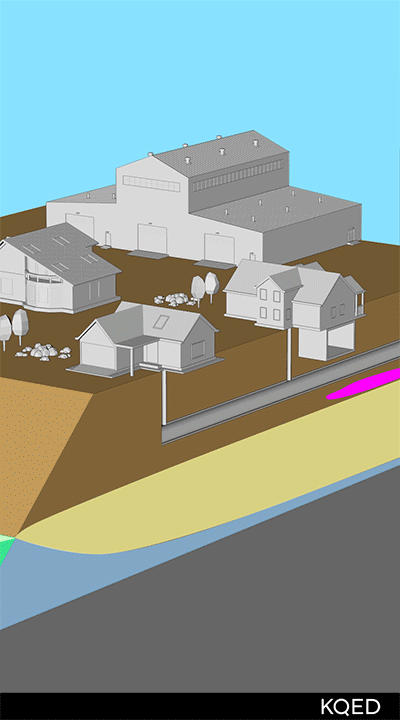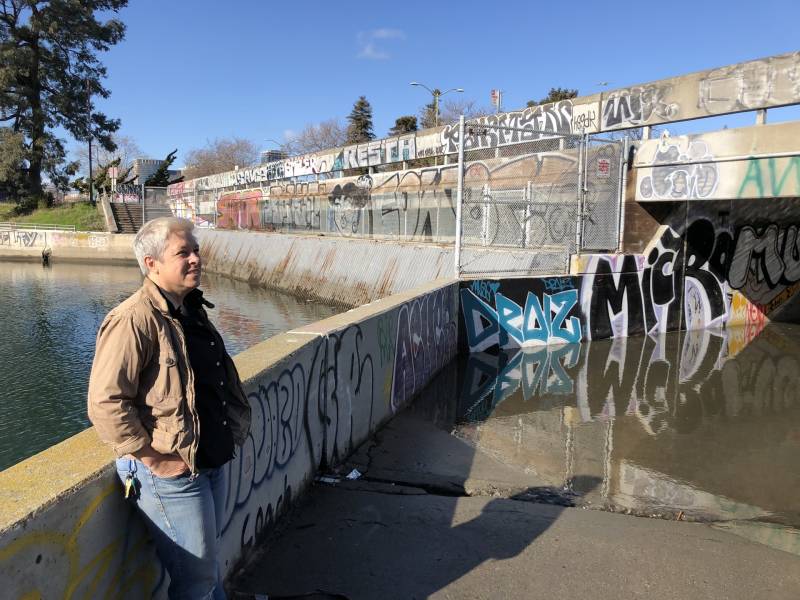Rising seas can evoke images of waves crashing into beachfront property or a torrent of water rolling through downtown streets. But there’s a lesser-known hazard of climate change for those who live along shorelines the world over: freshwater in the ground beneath them creeping slowly upward.
For many Bay Area residents who live near the water’s edge, little-publicized research indicates the problem could start to manifest in 10-15 years, particularly in low-lying communities like those in Oakland, Alameda and Marin City.
Groundwater rise can cause a host of infrastructure issues like crumbling roads, sewage backups and extended earthquake liquefaction zones. But water that moves silently higher can also have negative impacts on human and ecological health, by resurfacing toxic substances that have lingered for years underground.
“Everything human beings use, they spill,” said Kristina Hill, an associate professor at UC Berkeley’s College of Environmental Design, who researches adapting urban areas and shoreline communities to climate change. The overflow includes “everything we’ve used in the last hundred and fifty years,” Hill said.
And the “everything” she mentions is a lot. The Bay Area is rife with industrial sites, new and old. In East Oakland, industry boomed in the early 1900s, as lumber yards, canneries, rail depots and foundries sprung up. It was a long time before governments enacted any environmental regulations to speak of, starting in the 1960s.
“Through the entire postwar and World War II-era, stuff got dumped informally,” Hill said.
More recent contaminants lie buried as well — chemicals like benzene and toluene, leaked from underground storage tanks. Many toxic sites now considered to be contained could pose a threat as the water ascends.
“Legacy contamination in the soil will be remobilized when the water table comes up and intersects with these areas of contaminated soil,” Hill said.
That contaminated groundwater could seep into a basement or crawlspace beneath a home, or sneak in through a broken sewage line. Some of these chemicals vaporize, so that humans could breathe them in.
The vulnerable groundwater, which lies beneath the surface in a layer of freshwater sitting atop water from the ocean, could affect communities within a mile of the coast, according to a recent report by Silvestrum Climate Associates, detailing the problem in the Bay Area island city of Alameda.
“The relevant thing for the problem is how close [the groundwater] is to the surface,” said Hill. She and her colleagues have analyzed and published data estimating the depth of groundwater in Bay Area coastal communities. They found the water below someone’s backyard is “typically within 6 feet of the surface when you’re within a mile of the bay edge, and so often within 2 feet or 1 foot of the surface,” she said.
If the groundwater flows into contaminants no longer monitored because they are considered contained, those toxic substances may start to move, unnoticed.

“Now it’s possible that you have contamination in that water and you might not see it or smell it. You might not know,” said Alec Naugle, who heads the toxics cleanup division for the San Francisco Bay Regional Water Quality Control Board. The agency regulates the mitigation of contaminated sites in a large area stretching over the nine Bay Area counties.
“If you’re exposed to these chemicals over a lifetime, they can increase your risk of cancer,” Naugle said. “Some of those chemicals also have short-term risks at much higher concentrations that we don’t typically see in the environment.”
Professor Hill and her colleagues have found many locations across the Bay Area at risk. For example, Marin City, she says, has topography like a bowl, and as sea levels rise, it “will fill up with water.”
Many of these neighborhoods have large Black and Latino populations who already deal with unequal environmental health burdens due to living near major freeways and, in Oakland, the port. Residents of East and West Oakland have high rates of asthma, and children in East Oakland are more than twice as likely to suffer from the condition than their peers across Alameda County.
‘How Is That Going to Affect My Family?’
Marquita Price has always called Deep East Oakland, a section of city blocks laid out between two interstates, home. When she was a kid, her extended family spent a lot of time at her grandmother’s lavender house in the Havenscourt neighborhood.
“All of the kids, including myself, would con our parents to be able to all stay and just spend the night with our grandparents, and just sing and dance all night,” she said.

These days, Price is an urban planner for The East Oakland Collective, a nonprofit dedicated to racial and economic equality in the neighborhood.
A few years back, while participating in a design challenge calling for ways the Bay Area could prepare for climate change, Price learned about groundwater rise, and the slow-motion havoc it could wreak on her neighborhood.
She thought immediately of the people and places she loved, such as her grandmother’s home.
“How is that going to affect my family?” Price said, “And my community and the assets that we worked so hard to hold?”
Price then met Hill, the UC Berkeley professor, who has been raising the alarm about the threat of rising groundwater for years. Hill’s work has informed her activism on the issue.
“It’s something that people haven’t really thought of as an impact of sea level rise,” Hill said.
Hill says it’s no coincidence that large numbers of people of color live in low-lying areas that will likely face the threat of rising groundwater first.
“There was either redlining or restrictive homeowner covenants that prevented people of color from moving to neighborhoods on higher ground,” she said. “So effectively, white people … left them to live near the industrial areas and on low ground.”
